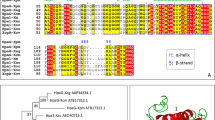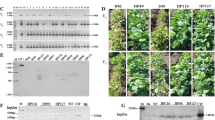Abstract
Harpin HrpZ from the plant-pathogen Pseudomonas spp. elicits the hypersensitive response (HR), pathogen defense responses, and enhances growth in plants. To identify regions of HrpZ related to these bioactivities, we constructed 11 mutants of HrpZPsgS1, a 346-amino-acid harpin protein from P. savastanoi pv. glycinea S1. Results showed that proteins HrpZ74–204 and HrpZ1–194 could not induce macroscopic HR but could elicit microscopic HR in tobacco. The HR elicitation activity of mutant proteins with other C-terminal deletions in HrpZPsgS1, such as HrpZ1–102, HrpZ△195–238, HrpZ△241–248, HrpZ△254–298, and HrpZ△290–313, was reduced. The activity of the remaining mutants, other than HrpZ200–346, which lacks part of the N-terminus, was similar to wild-type. These results indicate that the C-terminus is indispensable for HR elicitation, and that parts of the N-terminus play a regulatory role. Also, mutants HrpZΔ89–124 and HrpZΔ254–298 enhanced growth in rice more than wild-type HrpZPsgS1. These mutants were also more effective at inducing resistance to Xanthomonas oryzae pv. oryzae in rice and to Tobacco Mosaic Virus (TMV) in tobacco. qRT-PCR assays showed that HrpZΔ89–124 and HrpZΔ254–298 induced higher levels of expression in genes related to HR, pathogen defense, and growth. Therefore, the modified proteins HrpZΔ89–124 and HrpZΔ254–298 may have potential for development as protein-type biocontrol agents.







Similar content being viewed by others
References
Aarts, N., Metz, M., Holub, E., Staskawicz, B. J., Daniels, M. J., & Parker, J. E. (1998). Different requirements for EDS1 and NDR1 by disease resistance genes define at least two R gene-mediated signaling pathways in Arabidopsis. PNAS, 95, 10306–10311.
Berberich, T., Sugawara, K., Harada, M., & Kusano, T. (1995). Molecular cloning, characterization and expression of an elongation factor 1α gene in maize. Plant Molecular Biology, 29, 611–615.
Chen, C. H., Lin, H. J., & Feng, T. Y. (1998). An amphipathic protein from sweet pepper can dissociate harpinPss multimeric forms and intensify the harpin Pss-mediated hypersensitive response. Physiological and Molecular Plant Pathology, 52, 139–149.
Chen, L., Qian, J., Qu, S. P., Long, J. Y., Yin, Q., Zhang, C. L., et al. (2008a). Identification of specific fragments of HpaGXooc, a harpin protein from Xanthomonas oryzae pv. oryzicola, that induce disease resistance and enhance growth in rice. Phytopathology, 98, 781–791.
Chen, L., Zhang, S. J., Zhang, S. S., Qu, S. P., Ren, X. Y., Long, J. Y., et al. (2008b). A fragment of the Xanthomonas oryzae pv. oryzicola harpin HpaGXooc reduces disease and increases yield of rice in extensive grower plantings. Phytopathology, 98, 792–802.
Desikan, R., Reynolds, A., Hancock, J. T., & Neill, S. J. (1998). Harpin and hydrogen peroxide both initiate programmed cell death but have differential effects on defense gene expression in Arabidopsis suspension cultures. Biochemical Journal, 330, 115–120.
Desikan, R., Hancock, J. T., Ichimura, K., Shinozaki, K., & Neill, S. J. (2001). Harpin induces activation of the Arabidopsis mitogen-activated protein kinases AtMPK4 and AtMPK6. Plant Physiology, 126, 1579–1587.
Dong, H. S., Delaney, T. P., Bauer, D. W., & Beer, S. V. (1999). Harpin induces disease resistance in Arabidopsis through the systemic acquired resistance pathway mediated by salicylic acid and the NIM1 gene. The Plant Journal, 20, 207–215.
Dong, H. P., Peng, J. L., Bao, Z. L., Meng, X. D., Bonasera, J. M., Chen, G. Y., et al. (2004). Downstream divergence of the ethylene signaling pathway for harpin-stimulated Arabidopsis growth and insect defense. Plant Physiology, 136, 3628–3638.
Dong, H. P., Yu, H. Q., Bao, Z. L., Guo, X. J., Peng, J. L., Yao, Z., et al. (2005). The ABI2-dependent abscisic acid signaling controls HrpN-induced drought tolerance in Arabidopsis. Planta, 221, 313–327.
Engelhardt, S., Lee, J., et al. (2009). Separable roles of the pseudomonas syringae pv. Phaseolicola accessory protein HrpZ1 in ion-conducting pore formation and activation of plant immunity. The Plant Journal, 57, 706–717.
Gopalan, S., Wei, W., & He, S. (1996). hrp gene-dependent induction of hin1: a plant gene activated rapidly by both harpins and the avrPto gene-mediated signal. The Plant Journal, 10, 591–600.
Haapalainen, M., Engelhardt, S., Küfner, I., Li, C. M., Nürnberger, T., Lee, J., et al. (2011). Functional mapping of harpin HrpZ of Pseudomonas syringae reveals the sites responsible for protein oligomerization, lipid interactions and plant defence induction. Molecular Plant Pathology, 12(2), 151–166.
He, S. Y., Huang, H. C., & Collmer, A. (1993). Pseudomonas syringae pv. syringae harpinPss: a protein that is secreted via the hrp pathway and elicits the hypersensitive response in plants. Cell, 73, 1255–1266.
Huang, H. C., Hatcheson, S. W., & Collmer, A. (1991). Characterization of the hrp cluster from Pseudomonas syringae pv. syringae 61 and Tnpho a tagging of genes encoding exported or membrane-span-ning hrp proteins. Molecular Plant-Microbe Interactions, 4, 469–476.
Huo, R., Wang, Y., Ma, L., Qiao, J. Q., Shao, M., & Gao, X. W. (2010). Assessment of inheritance pattern and agronomic performance of transgenic rapeseed having harpin Xooc-encoding hrf2 Gene. Transgenic Research, 19, 841–847.
Jang, Y. S., Sohn, S. I., & Wang, M. H. (2006). The hrpN gene of Erwinia amylovora stimulates tobacco growth and enhances resistance to Botrytis cinerea. Planta, 223, 449–456.
Kandasamy, S., Loganathan, K., Muthuraj, R., Duraisamy, S., Seetharaman, S., Thiruvengadam, R., et al. (2009). Understanding the molecular basis of plant growth promotional effect of Pseudomonas fluorescens on rice through protein profiling. Proteome Science, 7(1), 47.
Kim, J. G., Jeon, E., Oh, J., Moon, J. S., & Hwang, I. (2004). Mutational analysis of Xanthomonas harpin HpaG identifies a key functional region that elicits the hypersensitive response in nonhost plants. Journal of Bacteriology, 186, 6239–6247.
Lee, J., Klessig, D. F., & Nürnberger, T. (2001a). A Harpin binding site in tobacco plasma membranes mediates activation of the pathogenesis-related gene HIN1 independent of extracellular calcium but dependent on mitogen-activated protein kinase activity. The Plant Cell, 13, 1079–1093.
Lee, J., Klusener, B., Tsiamis, G., Stevens, C., Neyt, C., et al. (2001b). HrpZ(Psph) from the plant pathogen Pseudomonas syringae pv. phaseolicola binds to lipid bilayers and forms an ion-conducting pore in vitro. Proceedings of the National Academy of Sciences of the United States of America, 98, 289–294.
Li, R., & Fan, Y. (1999). Reduction of lesion growth rate of late blight plant disease in transgenic potato expressing harpin protein. Science in China. Series C, Life Sciences, 42, 96–101.
Li, P., Lu, X. Z., Shao, M., Long, J. Y., & Wang, J. S. (2004). Genetic diversity of harpins from Xanthomonas oryzae and their activity to induce hypersensitive response and disease resistance in tobacco. Science in China. Series C, Life Sciences, 47, 461–469.
Li, C. M., Haapalainen, M., Lee, J., Nürnberger, T., Romantschuk, M., & Taira, S. (2005). Harpin of Pseudomonas syringae pv. phaseolicola harbors a protein binding site. Molecular Plant-Microbe Interactions, 18, 60–66.
Lin, X. H., Zhang, D. P., Xie, Y. F., Gao, H. P., & Zhang, Q. (1996). Identifying and mapping a new gene for bacterial blight resistance in rice based on RFLP markers. Phytopathology, 86, 1156–1159.
Oh, C. S., & Beer, S. V. (2007). AtHIPM, an Ortholog of the apple HrpN-interacting protein, is a negative regulator of plant growth and mediates the growth-enhancing effect of HrpN in Arabidopsis. Plant Physiology, 145, 426–436.
Pavli, O. I., Kelaidi, G. I., Tampakaki, A. P., & Skaracis, G. N. (2011). The hrpZ Gene of Pseudomonas syringae pv. phaseolicola Enhances Resistance to Rhizomania Disease in Transgenic Nicotiana benthamiana and Sugar Beet. PloS One, 6(3), e17306.
Peng, J. L., Dong, H. S., Dong, H. P., Delaney, T. P., Bonasera, B. M., & Beer, S. V. (2003). Harpin-elicited hypersensitive cell death and pathogen resistance requires the NDR1 and EDS1 genes. Physiological and Molecular Plant Pathology, 62, 317–326.
Peng, J. L., Bao, Z. L., Dong, H. S., Ren, H., & Wang, J. S. (2004a). Expression of harpinXoo in transgenic tobacco induces pathogen defense in the absence of hypersensitive cell death. Phytopathology, 94, 1048–1055.
Peng, J. L., Bao, Z. L., Ren, H., Wang, J. S., & Dong, H. S. (2004b). HarpinXoo and its functional domains activate pathogen-inducible plant promoters in Arabidopsis. Acta Botanica Sinica, 46, 1083–1090.
Pontier, D., Tronchet, M., Rogowsky, P., Lam, E., & Roby, D. (1998). Activation of hsr203, a plant gene expressed during incompatible plant-pathogen interactions, is correlated with programmed cell death. Molecular Plant-Microbe Interactions, 11, 544–554.
Preston, G., Huang, H. C., He, S. Y., & Collmer, A. (1995). The HrpZ proteins of Pseudomonas syringae pv. syringae, glycinea, and tomato are encoded by an operon containing Yersinia ysc homologs and elicit the hypersensitive response in tomato but not soybean. Molecular Plant-Microbe Interactions, 8, 717–732.
Ren, H. Y., Gu, G. Y., Long, J. Y., Qian, J., Wu, T. Q., Song, T., et al. (2006). Combinative effects of a bacterial type-III effector and a biocontrol bacterium on rice growth and disease resistance. Journal of Biosciences, 31, 617–627.
Shao, M., Wang, J. S., Dean, R. A., Lin, Y. J., Gao, X. W., & Hu, S. J. (2008). Expression of a harpin-encoding gene in rice confers durable nonspecific resistance to Magnaporthe grisea. Plant Biotechnology Journal, 6, 73–81.
Spoel, S. H., Koomneef, A., Claessens, S. M., et al. (2003). NPR1 modulates cross-talk between salicylate- and jasmonate-dependent defense pathways through a novel function in the cytosol. The Plant Cell, 15, 760–770.
Strobel, R. N., Gopalan, J. S., Kuc, J. A., & He, S. Y. (1996). Induction of systemic acquired resistance in cucumber by Pseudomonas syringae pv. syringae 61 HrpZPss protein. The Plant Journal, 9, 431–439.
Takakura, Y., Ishida, Y., Inoue, Y., Tsutsumi, F., & Kuwata, S. (2004). Induction of a hypersensitive response-like reaction by powdery mildew in transgenic tobacco expressing harpinpss. Physiological and Molecular Plant Pathology, 64, 83–89.
Tarafdar, P. K., Vedantam, L. V., Kondreddy, A., Podile, A. R., & Swamy, M. J. (2009). Biophysical investigations on the aggregation and thermal unfolding of harpinPss and identification of leucine-zipper-like motifs in harpins. Biochimica et Biophysica Acta, 1794, 1684–1692.
Waller, F., Furuya, M., & Nick, P. (2002). OsARF1, an auxin response factor from rice, is auxin-regulated and classifies as a primary auxin responsive gene. Plant Molecular Biology, 50, 415–425.
Wang, X. Y., Li, M., Zhang, J. H., Zhang, Y., Zhang, G. Y., & Wang, J. S. (2007). Identification of a key functional region in harpins from Xanthomonas that suppresses protein aggregation and mediates harpin expression in E. coli. Molecular Biology Reports, 34, 189–198.
Wei, Z. M., & Beer, S. V. (1996). Harpin from Erwinia amylovora induces plant resistance. Acta Horticulturae, 411, 223–225.
Wei, Z. M., Laby, R. J., Zumoff, C. H., Bauer, D. W., He, S. Y., Collmer, A., et al. (1992). Harpin, elicitor of the hypersensitive response produced by the plant pathogen Erwinia amylovora. Science, 257, 85–88.
Wei, Z. M., Fan, H., Stephens, J. J., Beer, S. V., & Laby, R. J. (2005). Hypersensitive response elicitor fragments which are active but do not elicit a hypersensitive response. United States Patent US, 6858707
Zhang, L., Xiao, S. S., Li, W. Q., Feng, W., Li, J., Wu, Z. D., et al. (2011). Overexpression of a harpin-encoding gene hrf1 in rice enhances drought tolerance. Journal of Experimental Botany, 62, 4229–4238.
Zitter, T. A., & Beer, S. V. (1998). Harpin for insect control. Phytopathology, 88, S104–S105.
Acknowledgments
This work was supported by grants from the National High-tech R&D Program of China (2012AA101504), the Special Fund for the Fundamental Research Funds for the Central Universities (KYZ201404), the National Transgenic Major Program on Cultivating New Transgenic Variety (2011ZX08004-004), the Agro-scientific Research in the Public Interest (20130315), and the National Natural Science Foundation of China (31100056, 31471811).
Author information
Authors and Affiliations
Corresponding author
Electronic supplementary material
ESM 1
(DOCX 3635 kb)
Rights and permissions
About this article
Cite this article
Wu, H., Zhang, Y., Zhang, H. et al. Identification of functional regions of the HrpZPsg protein from Pseudomonas savastanoi pv. glycinea that induce disease resistance and enhance growth in plants. Eur J Plant Pathol 147, 55–71 (2017). https://doi.org/10.1007/s10658-016-0979-6
Accepted:
Published:
Issue Date:
DOI: https://doi.org/10.1007/s10658-016-0979-6




